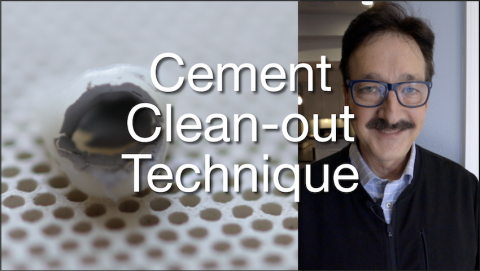Zirconia brand options in the CAD/CAM world are multiplying as we speak. Fortunately, this surge in material options provides a better creative menu to choose from when setting up our CEREC software for a bridge. We have e.max for anterior, zirconia multi-options for the premolar zone, and high strength zirconia when we still need the muscle material. We need to be familiar with the 3Y, 4Y, and 5Y zirconia selections, it will impact our prep style, reduction, aesthetics, and strength. Not all zirconia options have the same biofunctional strength. This video will provide an overview of zirconia bridge materials and the setup process in
Submitted by James Klim DDS, CADStar host on 02/20/2020 - 2:11pm
Submitted by James Klim DDS, CADStar host on 02/09/2020 - 8:55pm
This video documents my current steps for cementing an implant abutment or one-piece implant restoration on the TiBase. The protocol that I have changed as of late is using Monobond Etch & Prime rather than hydrofluoric acid and silane. I have experienced great success with my TiBase created implant restorations. I have yet to see an e.max or zirconia abutment delaminated from the TiBase in 8 years.
Cementation Steps:
- Sandblast the adhesive surface on the TiBase
- MonoBond Plus metal priming on TiBase
- Fill access screw tube with plumbers tape
- MonoBond Etch & Prime internal adhesive
Submitted by James Klim DDS, CADStar host on 02/06/2020 - 9:30pm
Submitted by James Klim DDS, CADStar host on 01/21/2020 - 9:11pm
This video will highlight my anterior ceramic shaping workflow for multiple anterior restorations, particularly when crossing the midline. However, anterior restorative success is mostly about understanding the patient's treatment expectations and then working through the biomechanical diagnosis and preplanning with either a traditional or digital wax-up.
The predetermined wax-up prototype is used for preparation guidelines and reduction, transitional restorations when using a two appointment protocol, and a digital BioCopy scan for digital design guidance. When these preliminary and preparatory guidelines are delivered to the
Submitted by James Klim DDS, CADStar host on 01/13/2020 - 9:46pm
2020 will be a year of growth and excitement at the Klim Institute online CEREC training. We have an evolving software and will see several new applications that will provide a full range of care options for our patients. As exciting...new materials entering our CAD/CAM market this year.
I am most impressed with MiYO, a liquid ceramic that is painted on our ceramics like a stain and glaze. The results are magical. This will bring our chairside aesthetics applications to a whole new level not yet experienced in our industry.
The Klim Institute Online will be adding two new channels this year... Full Mouth with CEREC and
Submitted by James Klim DDS, CADStar host on 12/16/2019 - 8:34pm
For posterior e.max restorations, spray glaze is one of the most effective ways to achieve an excellent luster finish. This video will walk through my spray glaze application technique for posterior e.max. For anterior teeth, I tend to apply brush-on glaze for more micro-surface texture control.
Make sure your whole team views this video, it is excellent for training and standardizing the e.max finishing workflow.
Submitted by James Klim DDS, CADStar host on 12/15/2019 - 3:01pm
Brush-on IPS Crystall glaze tutorial for all e.max glaze firing cycles and avoid glaze bubbling and surface glaze firing pits. This is precisely the posterior e.max glaze/stain technique I use in my clinical theater.
Make sure your whole team views this video, it is excellent for training and standardizing the e.max finishing workflow.
Submitted by James Klim DDS, CADStar host on 12/13/2019 - 12:55pm
This tutorial is the first part of the stain & glaze trilogy series for the Ivoclar rapid e.max firing cycle (and it works for all the e.max firing cycles). Once the restoration is milled, the e.max posterior restoration is efficiently shaped for morphological refinement, surface texture, and surface finish using the Dr. James Klim Meisinger JK03 Lab bur kit specially designed for CEREC users.
This video will show the burs and polishing workflow I use preparing e.max for either brush-on or spray glaze Make sure your whole team views this video, it is excellent for training and standardizing the e.max finishing workflow.
Submitted by James Klim DDS, CADStar host on 11/17/2019 - 9:30pm
What is the best way to clean-out cement when there is a crown or cement delamination? This video will document the furance temperature and effective way to clean-out cement and avoiding damaging the ceramic. This technique is also an excellent way to denature cement when needing to separate and remove the TiBase from an abutment or one-piece crown/abutment restoration if the color needs further enhancing.
Use a resting temperature of 550. Just close the furance cover at 550 P3 without activating P3 cycle.
Submitted by James Klim DDS, CADStar host on 11/04/2019 - 9:29pm











